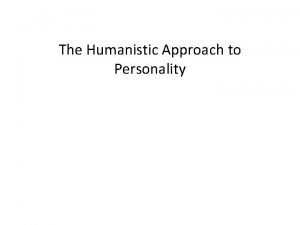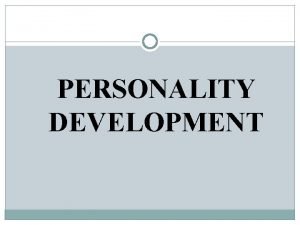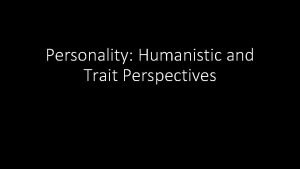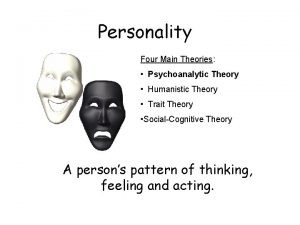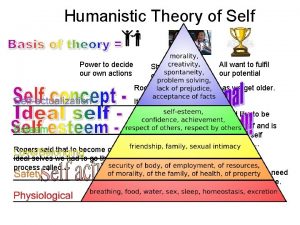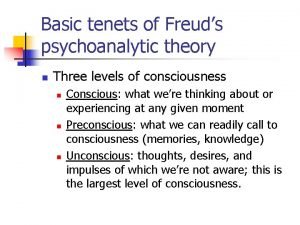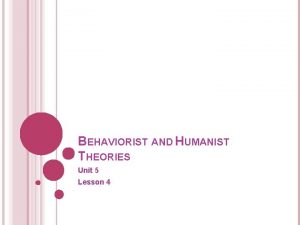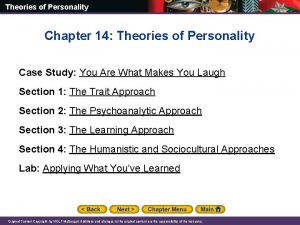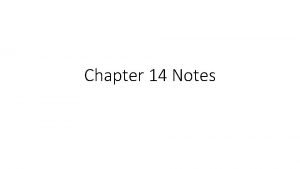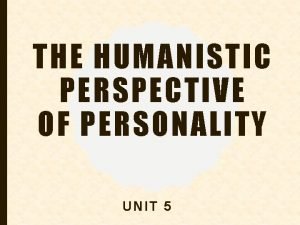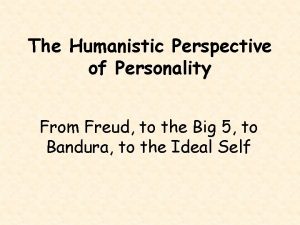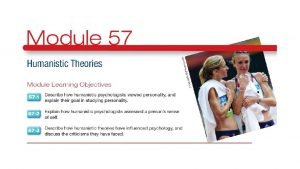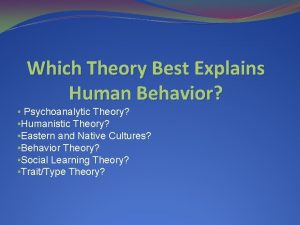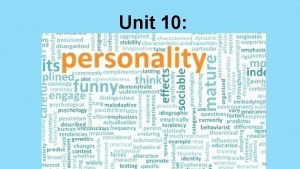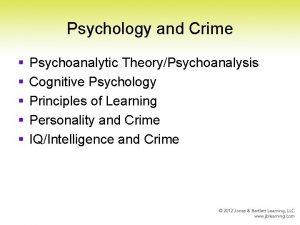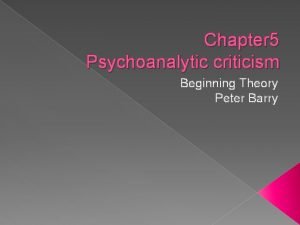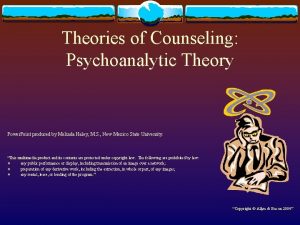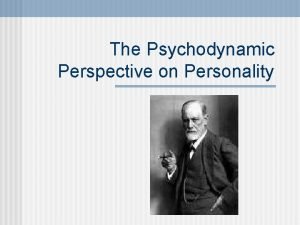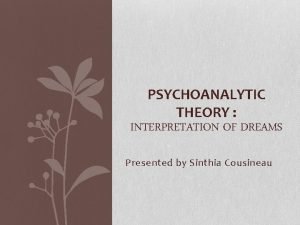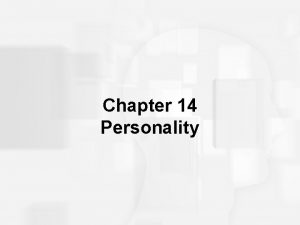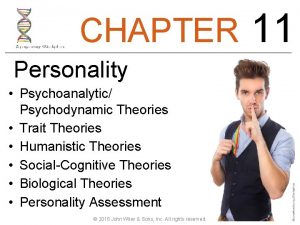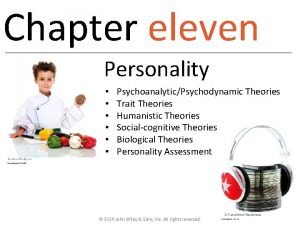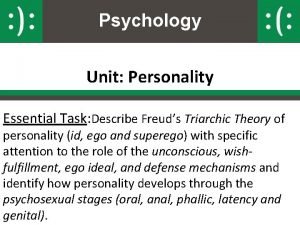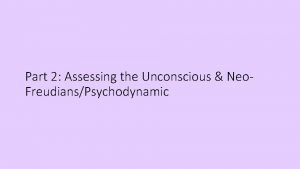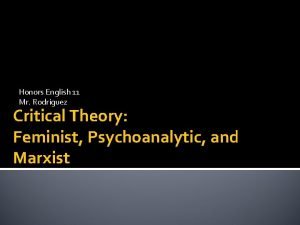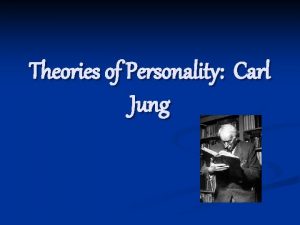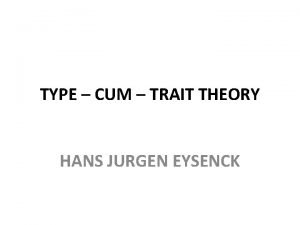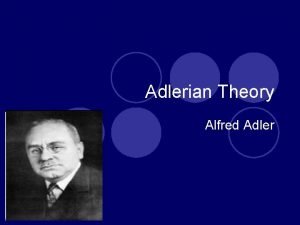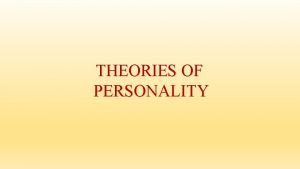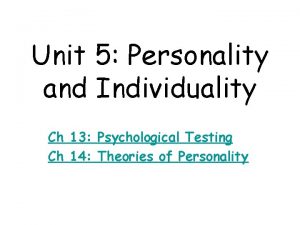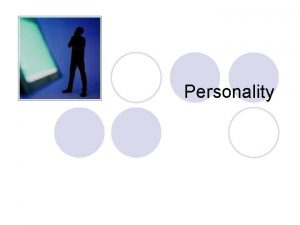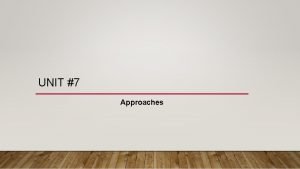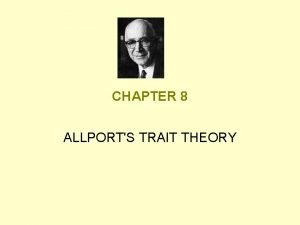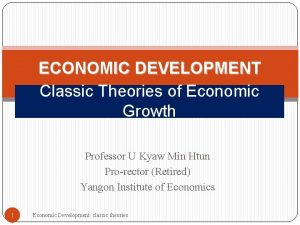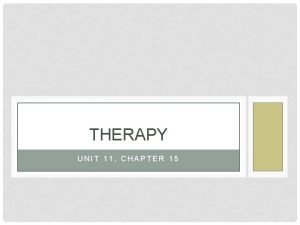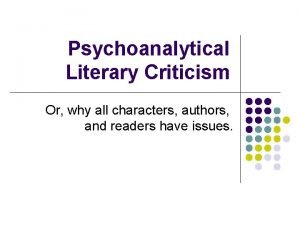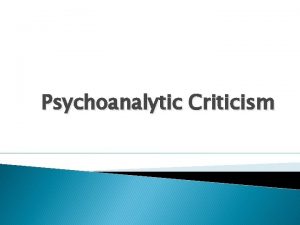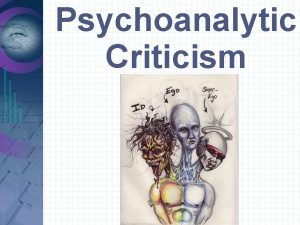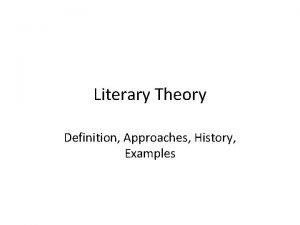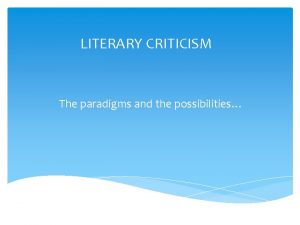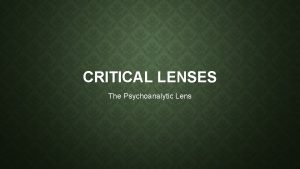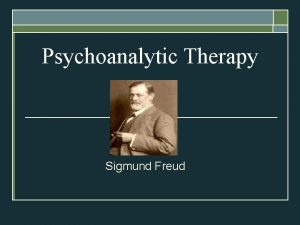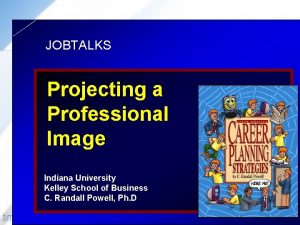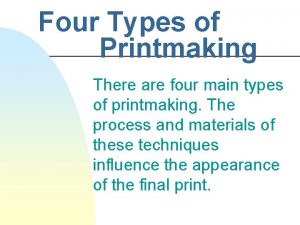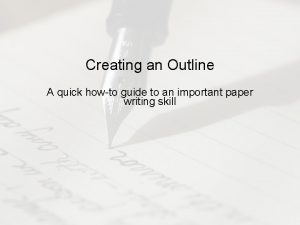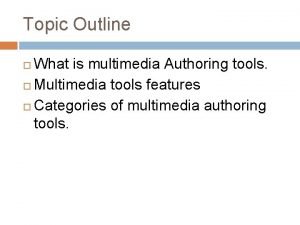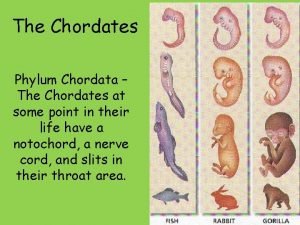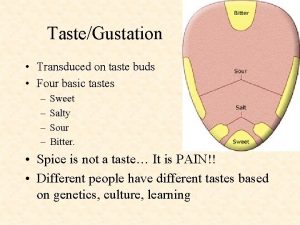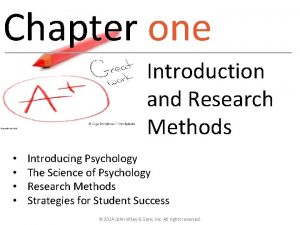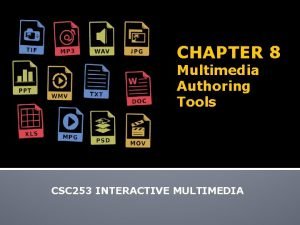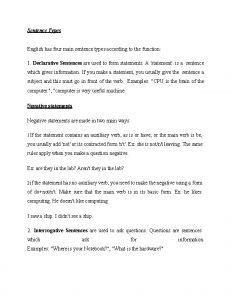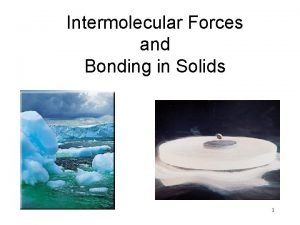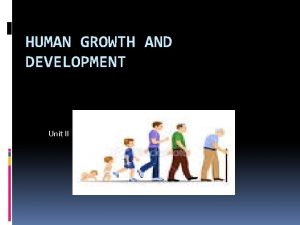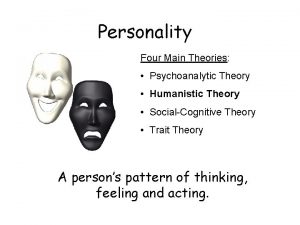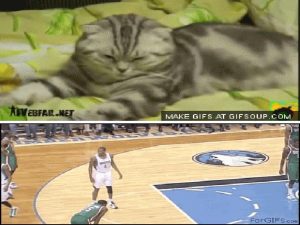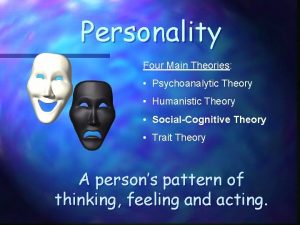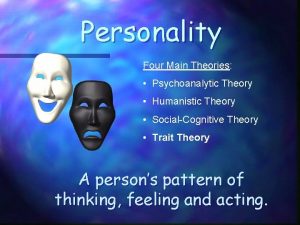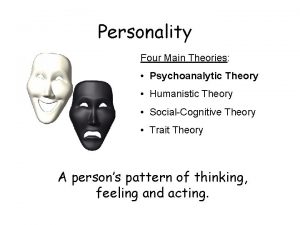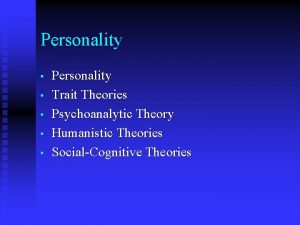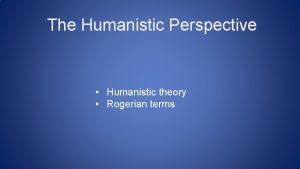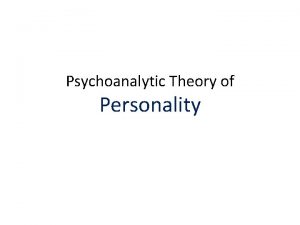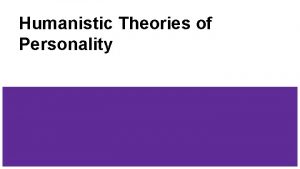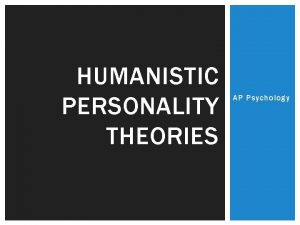Personality Four Main Theories Psychoanalytic Theory Humanistic Theory
















































































- Slides: 80

Personality Four Main Theories: • Psychoanalytic Theory • Humanistic Theory • Trait Theory • Social-Cognitive Theory A person’s pattern of thinking, feeling and acting.

Types of Personalities Type A Type B • Feel time pressure. • Relaxed and easygoing. • Easily angered. • But some people fit in neither type. • Competitive and ambitious. • Work hard and play hard. • More prone to heart disease than rest of population.


What is Personality? § Personality § an individual’s characteristic pattern of thinking, feeling, and acting § basic perspectives § Psychoanalytic § Humanistic

Psychoanalytic Theory • This theory is based off Sigmund Freud’s ideas • Psychoanalysis: attributes thoughts and actions to unconscious motives and conflicts • Freud says your personality is based off unconscious tensions you can’t control!!

What’s in Our Unconscious? • Conscious- things we are aware of. • Preconscious- things we can be aware of if we think of them. • Unconscious- unacceptable thoughts, wishes, feelings, desires, urges, memories – deep hidden reservoir that holds the true “us”. All of our desires and fears.

The Psychoanalytic Perspective § Free Association § in psychoanalysis, a method of exploring the unconscious § person relaxes and says whatever comes to mind, no matter how trivial or embarrassing

The Psychoanalytic Perspective § Unconscious § according to Freud, a reservoir of mostly unacceptable thoughts, wishes, feelings and memories § contemporary viewpoint- information processing of which we are unaware

Freud’s Concept of Personality (Psyche) • Ego • Superego • Id

Personality Structure § Id § contains a reservoir of unconscious psychic energy § strives to satisfy basic sexual and aggressive drives § operates on the pleasure principle, demanding immediate gratification

Id • Exists entirely in the unconscious (so we are never aware of it). • Our hidden true animalistic wants and desires. • Works on the Pleasure Principle • Avoid Pain and receive Instant Gratification.

Personality Structure § Superego § the part of personality that presents internalized ideals § provides standards for judgement (the conscience) and for future aspirations

Superego • Develops last at about the age of 5 • It is our conscience (what we think the difference is between right and wrong) • The Ego often mediates between the superego and id.

Personality Structure § Ego § the largely conscious, “executive” part of personality § mediates among the demands of the id, superego, and reality § operates on the reality principle, satisfying the id’s desires in ways that will realistically bring pleasure rather than pain

Ego • Develops after the Id • Works on the Reality Principle • Negotiates between the Id and the environment. • In our conscious and unconscious minds. • It is what everyone sees as our personality.

Personality Structure Ego Conscious mind Unconscious mind Superego Id § Freud’s idea of the mind’s structure


Defense Mechanisms • The ego has a pretty important job…and that is to protect you from threatening thoughts in our unconscious. • One way it protects us is through defense mechanisms. • You are usually unaware that they are even occurring.

Scenario Quarterback of the high school football team, Brandon, is dating Jasmine dumps Brandon and starts dating Drew, president of the chess club. Drew Jasmine Brandon

Repression • Pushing thoughts into our unconscious. • When asked about Jasmine, Brandon may say “Who? , I have not thought about her for awhile. ” • the basic defense mechanism that banishes anxietyarousing thoughts, feelings, and memories from consciousness

Denial • Not accepting the ego-threatening truth. • Brandon may act like he is still together with Jasmine. He may hang out by her locker and plan dates with her.

Displacement • Redirecting one’s feelings toward another person or object. • Often displaced on less threatening things. • Brandon may take his anger on another kid by bullying.

Projection • Believing that the feelings one has toward someone else are actually held by the other person and directed at oneself. • defense mechanism by which people disguise their own threatening impulses by attributing them to others • Brandon insists that Jasmine still cares for him.

Reaction Formation • Expressing the opposite of how one truly feels. • people may express feelings that are the opposite of their anxiety-arousing unconscious feelings • Cootie stage in Freud’s Latent Development. • Brandon claims he hates Jasmine.

Regression • Returning to an earlier, comforting form of behavior. • Brandon begins to sleep with his favorite childhood stiffed animal, Scruffy.

Rationalization • Coming up with a beneficial result of an undesirable outcome. • Brandon thinks he will find a better girlfriend. “Jasmine was not all that anyway!” • defense mechanism that offers self-justifying explanations in place of the real, more threatening, unconscious reasons for one’s actions

Intellectualization • Undertaking an academic, unemotional study of a topic. • Brandon starts doing a research paper on failed teenage romances.

Sublimation • Channeling one’s frustration toward a different goal. • Sometimes a healthy defense mechanism. • Brandon starts to learn how to play the guitar and writing songs (or maybe starts to body build).

Criticisms of Freud • He really only studied wealthy woman in Austria. • His results are not empirically verifiable (really hard to test). • No predictive power.

Neo-Freudians • These individuals accepted Freud’s basic ideas: the id, ego, and superego; the importance of the unconscious; the shaping of personality in childhood; and the dynamics of anxiety and defense mechanisms • BUT… they disagreed with Freud in other areas, especially the role sexual desires play (blamed social issues instead) • They changed the name to “Psychodynamic”

Alfred Adler • Believed the driving force in creating personality is the desire to overcome inferiority • Inferiority Complex: Children learning to overcome inadequacies from parents – the pattern they learn produces a lifestyle

Karen Horney • Criticized Freud’s masculine view of psychology and the idea that the female was naturally inferior • Said men had “womb envy” • Childhood Anxiety – a child’s helplessness requires him/her to seek love and security. • Therefore, personality is built on this early fight against rejection.

Carl Jung • Expanded concept of unconscious to include a collective unconscious – a shared, inherited reservoir of memory traces from the species’ history. • Collective Unconscious contains archetypes – specific inherited ideas. • Examples: supreme being, nurturing mother, wise man, hostile brother, rebirth, wicked witches…

How do we explore your unconscious? • Free Association: exploring the unconscious by relaxing and saying whatever comes to mind, no matter how trivial or embarrassing • Freud also explored the unconscious through dream analysis Sigmund Freud

Getting into the Unconscious cont. • Hypnosis • Dream Interpretation • Projective Tests (and test that delves into the unconscious). • Examples are TAT and Inkblot Tests.

Assessing the Unconscious § Projective Test § a personality test, such as the Rorschach or TAT, that provides ambiguous stimuli designed to trigger projection of one’s inner dynamics § Thematic Apperception Test (TAT) § a projective test in which people express their inner feelings and interests through the stories they make up about ambiguous scenes

TAT Test Thematic Apperception Test • Giving the subject a picture that is ambiguous (can have several meanings) and ask them what is occurring. • Their answers reveal the manifest content. • They can then discover the Latent Content.

Assessing the Unconscious-TAT

Assessing the Unconscious-Rorschach







Assessing the Unconscious § Rorschach Inkblot Test § the most widely used projective test § a set of 10 inkblots designed by Hermann Rorschach § seeks to identify people’s inner feelings by analyzing their interpretations of the blots

Rorschach Inkblot Test • The most widely used projective test • A set of ten inkblots designed to identify people’s feelings when they are asked to interpret what they see in the inkblots.








What’s Your STYLE? You probably see a main image or character in each inkblot. Where is that main image in relation to the whole inkblot? To the right of center – you focus on the future To the left of the center – you focus on the past In the center – you focus on the here and now In the dark blots – you think the way most people do In the white spaces – you are an unusual, perhaps creative thinker • In the upper portions of the inkblot (or if you see your image moving upward) – you are an achiever • In the lower portions of the inkblot (or if you see your image falling down) – you are sad about something • • •

What’s Your STYLE? What kinds of images do you see most often? • Inanimate objects – you are good at mechanical things • Abstract ideas (like joy or freedom) – you enjoy dealing with ideas • Plants or animals – you are a nature lover • People – you are sociable • Food – you like to take care of people or be taken care of • Action – you are a doer rather than a thinker (or maybe you are both) • Danger or aggression – you are angry or worried about something

Humanistic Perspective § Abraham Maslow (19081970) § studied selfactualization processes of productive and healthy people (e. g. , Lincoln)

Humanistic Perspective § Self-Actualization § the ultimate psychological need that arises after basic physical and psychological needs are met and self-esteem is achieved § the motivation to fulfill one’s potential

Humanistic Perspective § Carl Rogers (1902 -1987) § focused on growth and fulfillment of individuals § genuineness § acceptance § empathy

Humanistic Perspective § Unconditional Positive Regard § an attitude of total acceptance toward another person § Self-Concept § all our thoughts and feelings about ourselves, in an answer to the question, “Who am I? ”

Trait Theories of Personality • Trait: a characteristic pattern of behavior or a disposition to feel and act • They believe that we can describe people’s personalities by specifying their main characteristics (traits). • Traits like honesty, laziness, ambition, outgoing are thought to be stable over the course of your lives.

Trait Theories • Personality Inventories – questionnaire used to measure a person’s score on certain traits • Minnesota Multiphasic personality Inventory (MMPI) – most widely researched and clinically used of all personality tests • BIG FIVE personality traits: (remember CANOE) Conscientiousness Agreeableness Neuroticism Openness to experience Extraversion 1. 2. 3. 4. 5. Factor Analysis is used to see the clusters and score these tests.

Conscientiousness • High – Organized – Careful – Disciplined • Low – Disorganized – Careless – Impulsive

Intraversion/Agreeableness • High – Soft-hearted – Trusting – Helpful • Low – Ruthless – Suspicious – Uncooperative

Emotional Stability /Neuroticism • High – Anxious – Insecure – Self-pitying • Low – Calm – Secure – Self-satisfied

Openness to Experience • High – Imaginative – Likes variety – Independent • Low – Practical – Likes routine – Conforming

Extraversion • High – Sociable – Fun-loving – Affectionate • Low – Retiring – Sober – Reserved

Contemporary Research-- The Trait Perspective § Trait § a characteristic pattern of behavior § a disposition to feel and act, as assessed by selfreport inventories and peer reports § Personality Inventory § a questionnaire (often with true-false or agreedisagree items) on which people respond to items designed to gauge a wide range of feelings and behaviors § used to assess selected personality traits

The Trait Perspective Moody Anxious Rigid Sober Pessimistic Reserved Unsociable Quiet UNSTABLE § Hans and Sybil Eysenck use two primary personality factors as axes for describing EXTRAVERTED personality variation Touchy Restless Aggressive Excitable Changeable Impulsive Optimistic Active melancholic choleric INTROVERTED phlegmatic sanguine Passive Careful Thoughtful Peaceful Controlled Reliable Even-tempered Calm Sociable Outgoing Talkative Responsive Easygoing Lively Carefree Leadership STABLE

The Trait Perspective The “Big Five” Personality Factors Trait Dimension Description Emotional Stability Calm versus anxious Secure versus insecure Self-satisfied versus self-pitying Extraversion Sociable versus retiring Fun-loving versus sober Affectionate versus reserved Openness Imaginative versus practical Preference for variety versus preference for routine Independent versus conforming Intraversion Conscientiousness Soft-hearted versus ruthless Trusting versus suspicious Helpful versus uncooperative Organized versus disorganized Careful versus careless Disciplined versus impulsive

Social-Cognitive Perspective § views behavior as influenced by the interaction between persons and their social context § Reciprocal Determinism § the interacting influences between personality and environmental factors

Social-Cognitive Perspective

Social-Cognitive Perspective § Personal Control § our sense of controlling our environments rather than feeling helpless § External Locus of Control § the perception that chance or outside forces beyond one’s personal control determine one’s fate

Social-Cognitive Perspective § Internal Locus of Control § the perception that one controls one’s own fate § Learned Helplessness § the hopelessness and passive resignation an animal or human learns when unable to avoid repeated aversive events

Social-Cognitive Perspective § Learned Helplessness Uncontrollable bad events Perceived lack of control Generalized helpless behavior

Social-Cognitive Perspective § Positive Psychology § the scientific study of optimal human functioning § aims to discover and promote conditions that enable individuals and communities to thrive

Exploring the Self § Spotlight Effect § overestimating others noticing and evaluating our appearance, performance, and blunders § Self Esteem § one’s feelings of high or low self-worth § Self-Serving Bias § readiness to perceive oneself favorably

Exploring the Self § Individualism § giving priority to one’s own goals over group goals and defining one’s identity in terms of personal attributes rather than group identifications § Collectivism § giving priority to the goals of one’s group (often one’s extended family or work group) and defining one’s identity accordingly

Exploring the Self Value Contrasts Between Individualism and Collectivism Concept Individualism Collectivism Self Independent (identity from individual traits) Interdependent identity from belonging) Life task Discover and express one’s uniqueness Me--personal achievement and fullfillment; rights and liberties Maintain connections, fit in What matters We-group goals and solidarity; social responsibilities and relationships Coping method Change reality Accommodate to reality Morality Defined by individuals (self-based) Defined by social networks (duty-based) Relationships Many, often temporary or casual; confrontation acceptable Few, close and enduring; harmony valued Attributing behaviors Behavior reflects one’s personality and attitudes Behavior reflects social and roles

The Modern Unconscious Mind § Terror-Management Theory § Faith in one’s worldview and the pursuit of self-esteem provide protection against a deeply rooted fear of death
 Humanistic approach of personality
Humanistic approach of personality Psychoanalytic vs humanistic
Psychoanalytic vs humanistic Humanistic therapies aim to boost
Humanistic therapies aim to boost Freudian personality theory
Freudian personality theory Humanistic strengths and weaknesses
Humanistic strengths and weaknesses Sublimation defence mechanism
Sublimation defence mechanism Humanistic
Humanistic Basic tenets of psychoanalytic theory
Basic tenets of psychoanalytic theory The freudian concept of the ego is best described as *
The freudian concept of the ego is best described as * Social cognitive approaches to personality
Social cognitive approaches to personality Cognitive learning theory
Cognitive learning theory Lesson 4 humanistic theories
Lesson 4 humanistic theories Rogers view of personality
Rogers view of personality Undoing defense mechanism examples
Undoing defense mechanism examples What does the psychoanalytic approach to personality teach?
What does the psychoanalytic approach to personality teach? Humanistic perspective on personality
Humanistic perspective on personality The humanistic perspective of personality
The humanistic perspective of personality Humanistic psychologists may assess personality by
Humanistic psychologists may assess personality by Type of theories
Type of theories Ego reality principle
Ego reality principle Psychoanalytic theory criminology
Psychoanalytic theory criminology Psychoanalytic criticism peter barry
Psychoanalytic criticism peter barry Psychoanalytic theory defense mechanisms
Psychoanalytic theory defense mechanisms Sigmund freud psychoanalytic theory
Sigmund freud psychoanalytic theory Psychodynamic approach to personality
Psychodynamic approach to personality Psychodynamic theory of dreaming
Psychodynamic theory of dreaming Erikson's psychoanalytic theory of development
Erikson's psychoanalytic theory of development Freudian personality test
Freudian personality test Social cognitive theory of personality examples
Social cognitive theory of personality examples Freud psychoanalytic theory
Freud psychoanalytic theory Castration anxiety
Castration anxiety Sublimation in defence mechanism
Sublimation in defence mechanism Neo freudian theory
Neo freudian theory Psychoanalytic
Psychoanalytic Carl jung theory of personality
Carl jung theory of personality Personality in consumer behavior
Personality in consumer behavior Type cum trait approach
Type cum trait approach Alfred adler's theory
Alfred adler's theory Type approach
Type approach Trait theories of personality _____.
Trait theories of personality _____. L
L Humanistic theory carl rogers
Humanistic theory carl rogers Humanism psychologist
Humanism psychologist Difference between humanistic and trait theory
Difference between humanistic and trait theory Humanistic theory
Humanistic theory Normative society
Normative society Classic theories of economic development: four approaches
Classic theories of economic development: four approaches Language
Language Dabe main daba dabe main cake
Dabe main daba dabe main cake A.1 determine the main idea of a passage
A.1 determine the main idea of a passage Void main int main
Void main int main Psychodynamic vs psychoanalytic
Psychodynamic vs psychoanalytic Psychoanalytical criticism
Psychoanalytical criticism Psychological criticism
Psychological criticism Definition of psychoanalytic criticism
Definition of psychoanalytic criticism Psychoanalysis focuses on
Psychoanalysis focuses on Literary approach definition
Literary approach definition 4 critical variables of literary theory and criticism
4 critical variables of literary theory and criticism Psychological lens examples
Psychological lens examples Psychoanalytic techniques
Psychoanalytic techniques Structure of a fern
Structure of a fern Kingdom eukariotik
Kingdom eukariotik Professional image university
Professional image university Kinds of printmaking
Kinds of printmaking Four main components for effective outlines
Four main components for effective outlines Defining technical communication
Defining technical communication Four main perspectives in multimedia authoring tools
Four main perspectives in multimedia authoring tools What are the four main characteristics of chordates
What are the four main characteristics of chordates Basic tastes
Basic tastes Hemichordata
Hemichordata Four main goals of psychology
Four main goals of psychology Advantages of icon based authoring tool
Advantages of icon based authoring tool What does ghs stand for whmis
What does ghs stand for whmis Four main sentence types
Four main sentence types Setting in a folktale
Setting in a folktale What are the three features of folktales
What are the three features of folktales Four main branches of oceanography
Four main branches of oceanography 4 parts of the brain
4 parts of the brain What are the stages of the cell cycle
What are the stages of the cell cycle Network covalent
Network covalent Four main types of growth and development
Four main types of growth and development
